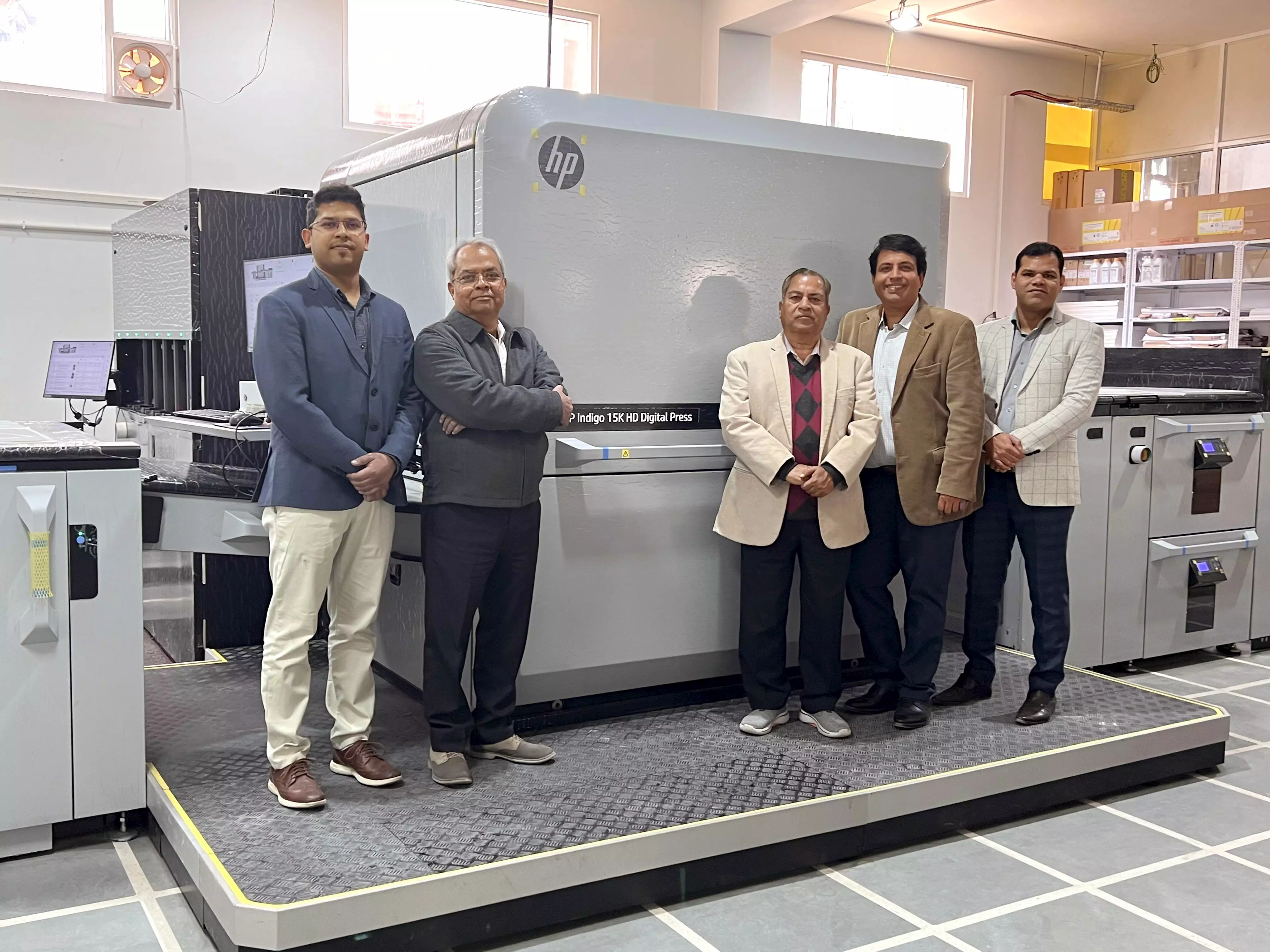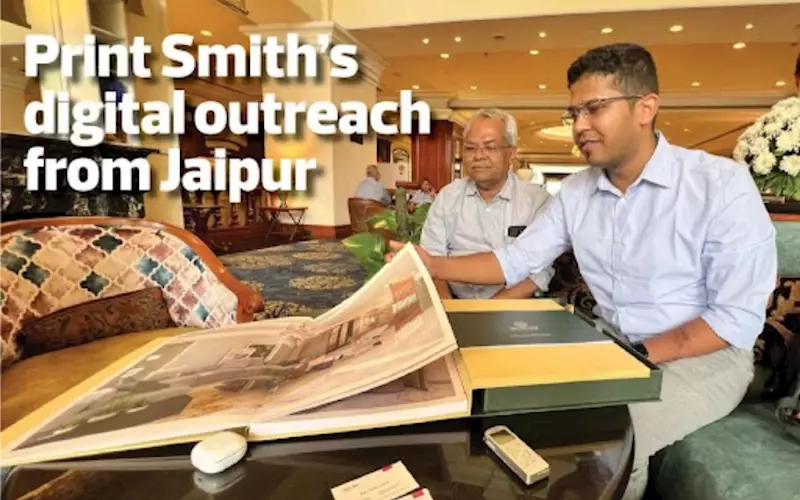Print Smith's digital outreach from Jaipur - The Noel D'Cunha Sunday Column
Print Smith is Jaipur Printers’ digital arm. Seven years ago, the company produced seven-lakh University certificates in 20 days. Recently, the company installed the HP Indigo 15K HD digital printing press, which helped it create specialised short-run prints in the photo album segment and commercial jobs. The Sunday Column talks to Aditya Jain
09 Jul 2023 | By Noel D'Cunha
Print service providers face a challenge. Shrinking print runs, plus demand for quality print. This is especially true for a legacy business, Jaipur Printers. Established by the Late Sohan Lal Jain in 1948, the Jaipur-based print firm has been a synonym for quality printing.
It all began with a small printing press equipped with two Chandler Price treadle letterpress and a few ancillary machines (typesetting with hotmelt types). When Alok Jain joined the business as a second generation in 1983, he strengthened the set-up with the latest printing equipment and finishing line. The transformation was complete. An offset print house with a rep to protect. As a one-stop solution provider, Jaipur Printers has an in-house quality control and delivery system to provide value and satisfaction to its customers in Jaipur and Delhi-NCR, as well as Rajasthan.
Today, Jaipur Printers is in reboot mode. It has added arsenal to its digital business. The aim: to tap the upcoming short runs, personalisation, and variable data printing trends. That's why Aditya Jain joined the business. Print Smith was his dream project. On cue, Print Smith installed the HP Indigo 15K HD at its newly established 9,000-sqft production plant in Sitapura Industrial Area in Jaipur.
“We believe digital customers are ready to pay a premium for the best-in-class prints. Today as an organisation, we have a capacity on the offset side to manage longer print runs, and now with the growing need for short runs and premium quality, we have a digital set-up also. Now, we can service both kinds of clients and requirements,” says Aditya Jain.
Excerpts of Aditya Jain's conversation with Noel D'cunha
Noel D'cunha (ND): What you explained sounds like premium printing, which means it will attract a higher price tag. What is the profile of the customers?
Aditya Jain (AJ): If the requirements are specialised, the customer is willing to pay. We have customers who want prints on coloured sheets but don’t want the fibres to be visible, which means printing a layer of premium white.
ND: So, customers who need such luxury do pay a premium ...
AJ: Recently we received an enquiry for printing a job, which among other types of paper, also required vintage paper. The first 20 pages required vintage, the next 50 on art paper and the remaining 30-pages on general paper. We could entertain such an inquiry because the HP Indigo 15K.
ND: It gave us flexibility, in terms of substrate usage and special ink technology, to print our customer’s demand.
AJ: Yes. Recently we did a job where we had to print 2,000 copies of a book. Approximately 10,000 sheets were printed. The job was to be shipped to Sweden. It was to be printed on cartridge paper (a rough, non-coated paper).
ND: Sounds like a prestigious project. You produced a dummy?
AJ: We made a dummy of the print job using the HP Indigo 15K press. The client approved the job. Initially, we planned to print it in our offset division, but since offset absorbs inks, the colours were not as bright as on the digital dummy. We explained it to the client, and he agreed on the revised pricing, and we then used the HP Indigo 15K press to execute the order.
ND: Which are the segments that look at premium printing? Where do you see print growth in Jaipur?
AJ: Segments like gems, jewellery, luxury, hospitality, and real estate are growing in Jaipur. With the HP Indigo 15K press, we are ready to meet the demands.

ND: How so?
AJ: In one of our unique jobs, we developed 500 catalogues for a French real estate company. It is a combination of print, converting and electronics. Those 500 catalogues consist of a tab for audio-video and a virtual project tour. The printing required special treatment because the solid colour gamut and post-press was also a challenge. And the size of the catalogue was big.
ND: HP Indigo has claimed its CMYK plus OVG can produce prints 96% close to Pantone shades. What is your experience?
AJ: Yes, we have been doing Pantone shade jobs for a few export-oriented customers. Earlier, these brands used different sampling methods, but with the digital proofing we provide, it has become easier for them to meet their requirements. Plus, the samples are ready within half an hour.
PW: Do you work on the print-ready files that you receive?
AJ: We have a pre-press department, and if required, we work on those files for a day or two.
ND: The other significant feature of the HP Indigo presses is that one can use a wide variety of substrates to produce prints. Which kinds of substrates do you deploy?
AJ: We print on paper, including the coloured media, because we have the premium white module installed, which enables us to cater to such demands. More importantly, we print on canvas. There are artists as well as customers in the hotel and hospitality segments that require paintings and pictures for the rooms or lobbies. We replicate these scanned images of the paintings, which are close to the original ones.
ND: What is your sustainability score?
AJ: Brands that come to us and seek sustainable solutions. We print on Kraft paper, which is generally made out of waste content, so it is that much greener. Earlier, we could not print on such substrates, but with the white components of the HP Indigo system, we can easily cater to such needs of our customers.
ND: How so?
AJ: In short, the HP Indigo’s ability to handle different substrates coupled with the CMYK + OVG + White does the trick for us.
ND: Printing on such substrates would mean using more inks. Do you pay more for such prints? What does your FSMA say?
AJ: So, we are in a sweet spot, such that we don’t have to worry about the ink consumption. Even if it is 400% more, we pay the same amount as is specified. However, we have requested the HP team to look into the area of ink consumption, whether low or high.
ND: Can you explain?
AJ: We need a running cost model if we need to grow our digital operation. We need that advantage or differentiation to move the job to digital and not look toward our offset operation to execute the job, particularly where printing offset, under normal circumstances, works out cheaper.
ND: The machine can produce high-capacity printing with offset-style stacking to feed paper sheets. That’s more suited for long runs, so for a photo-album, it is not really too much of a help...
AJ: The machine has two different output trays. One is the proof tray which we usually use for short-runs like customised or personalised commercial printing, coffee-table books, retail and real estate brochures and photo printing, where we have to ensure perfect picture quality. The stacker is used for longer-run jobs, say printing 500-plus sheets. For example, the order for a photo-album is received in batches – 20 to 30 sheets each in five to six albums. While we can easily do it using the proof tray, we prefer to use the stacker because it is easy to handle the jobs, and it is easy for the workflow down the line. We follow what most photo-album service providers do: use the proof tray for photo segments.
ND: What do you do for offset jobs?
AJ: For an offset-like job, we use the stacker.
ND: Coffee-table books and photo albums are about consistent prints. How does the new HP Indigo 15K press help?
AJ: HP Indigo presses have a closed-loop system wherein once the calibration is done at the beginning of the day, print quality, colour, and shades are consistent. Therefore, among many unique features, this is one of the features where we get consistent prints from the beginning.
ND: How is it achieved?
AJ: The press has the ability to scan every image that is going to be printed. A feedback loop sends a message to the print engine that something is wrong and corrections must be done before it is printed. This correction mechanism takes command and stabilises the print quality to the quality of the previous print. We also set a tolerance threshold that tells the machine to correct it or stop printing if it is beyond the tolerance.
ND: What about your HP Indigo team?
AJ: Our operators are trained, and they have been instructed to ensure the best print quality.
ND: Anything interesting in the pipeline for Print Smith?
AJ: As we are known for quality and good customer service, we also want to bring lots of innovation with our digital set-up.
ND: Today's customers are highly demanding, and they need to "experience" print. How do you enable this?
AJ: We have started working on a website called “peppyprints.com” where customers can create snap books, posters, photo calendars, order photo frames, photo prints, and Polaroid prints online.
ND: Sounds good.
AJ: Stay tuned as we are working on improved design and experience.











 See All
See All